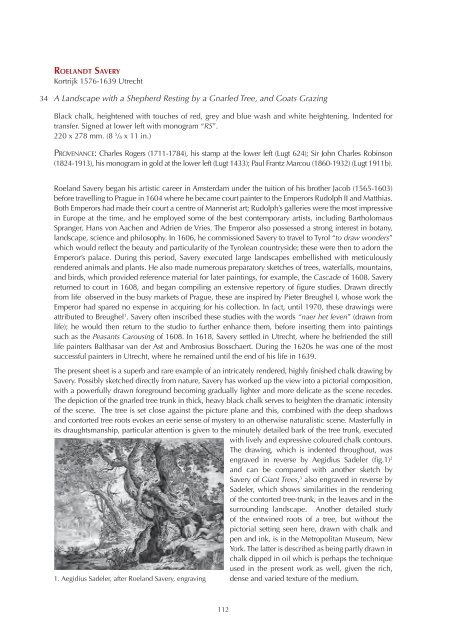Catalogue-2014-Jean-Luc-Baroni
- No tags were found...
Create successful ePaper yourself
Turn your PDF publications into a flip-book with our unique Google optimized e-Paper software.
Roelandt Savery<br />
Kortrijk 1576-1639 Utrecht<br />
34<br />
A Landscape with a Shepherd Resting by a Gnarled Tree, and Goats Grazing<br />
Black chalk, heightened with touches of red, grey and blue wash and white heightening. Indented for<br />
transfer. Signed at lower left with monogram “RS”.<br />
220 x 278 mm. (8 5 /8 x 11 in.)<br />
Provenance: Charles Rogers (1711-1784), his stamp at the lower left (Lugt 624); Sir John Charles Robinson<br />
(1824-1913), his monogram in gold at the lower left (Lugt 1433); Paul Frantz Marcou (1860-1932) (Lugt 1911b).<br />
Roeland Savery began his artistic career in Amsterdam under the tuition of his brother Jacob (1565-1603)<br />
before travelling to Prague in 1604 where he became court painter to the Emperors Rudolph II and Matthias.<br />
Both Emperors had made their court a centre of Mannerist art; Rudolph’s galleries were the most impressive<br />
in Europe at the time, and he employed some of the best contemporary artists, including Bartholomaus<br />
Spranger, Hans von Aachen and Adrien de Vries. The Emperor also possessed a strong interest in botany,<br />
landscape, science and philosophy. In 1606, he commissioned Savery to travel to Tyrol “to draw wonders”<br />
which would reflect the beauty and particularity of the Tyrolean countryside; these were then to adorn the<br />
Emperor’s palace. During this period, Savery executed large landscapes embellished with meticulously<br />
rendered animals and plants. He also made numerous preparatory sketches of trees, waterfalls, mountains,<br />
and birds, which provided reference material for later paintings, for example, the Cascade of 1608. Savery<br />
returned to court in 1608, and began compiling an extensive repertory of figure studies. Drawn directly<br />
from life observed in the busy markets of Prague, these are inspired by Pieter Breughel I, whose work the<br />
Emperor had spared no expense in acquiring for his collection. In fact, until 1970, these drawings were<br />
attributed to Breughel 1 . Savery often inscribed these studies with the words “naer het leven” (drawn from<br />
life); he would then return to the studio to further enhance them, before inserting them into paintings<br />
such as the Peasants Carousing of 1608. In 1618, Savery settled in Utrecht, where he befriended the still<br />
life painters Balthasar van der Ast and Ambrosius Bosschaert. During the 1620s he was one of the most<br />
successful painters in Utrecht, where he remained until the end of his life in 1639.<br />
The present sheet is a superb and rare example of an intricately rendered, highly finished chalk drawing by<br />
Savery. Possibly sketched directly from nature, Savery has worked up the view into a pictorial composition,<br />
with a powerfully drawn foreground becoming gradually lighter and more delicate as the scene recedes.<br />
The depiction of the gnarled tree trunk in thick, heavy black chalk serves to heighten the dramatic intensity<br />
of the scene. The tree is set close against the picture plane and this, combined with the deep shadows<br />
and contorted tree roots evokes an eerie sense of mystery to an otherwise naturalistic scene. Masterfully in<br />
its draughtsmanship, particular attention is given to the minutely detailed bark of the tree trunk, executed<br />
with lively and expressive coloured chalk contours.<br />
The drawing, which is indented throughout, was<br />
engraved in reverse by Aegidius Sadeler (fig.1) 2<br />
and can be compared with another sketch by<br />
Savery of Giant Trees, 3 also engraved in reverse by<br />
Sadeler, which shows similarities in the rendering<br />
of the contorted tree-trunk, in the leaves and in the<br />
surrounding landscape. Another detailed study<br />
of the entwined roots of a tree, but without the<br />
pictorial setting seen here, drawn with chalk and<br />
pen and ink, is in the Metropolitan Museum, New<br />
York. The latter is described as being partly drawn in<br />
chalk dipped in oil which is perhaps the technique<br />
used in the present work as well, given the rich,<br />
1. Aegidius Sadeler, after Roeland Savery, engraving dense and varied texture of the medium.<br />
112
















